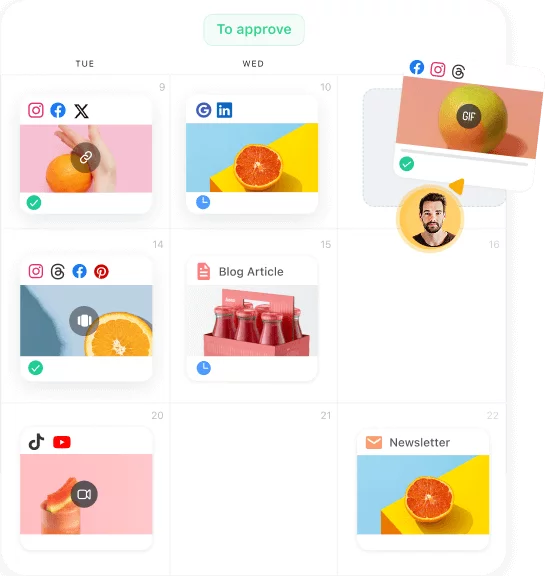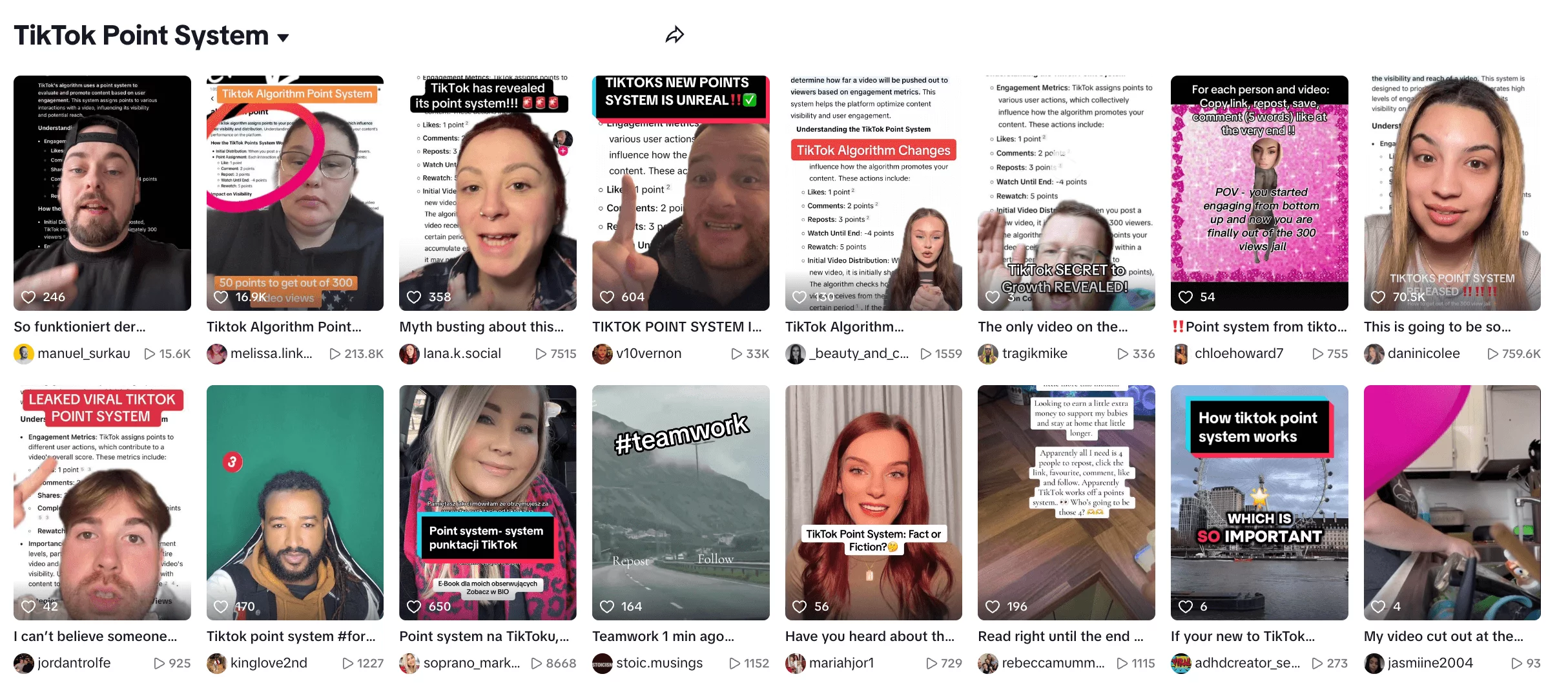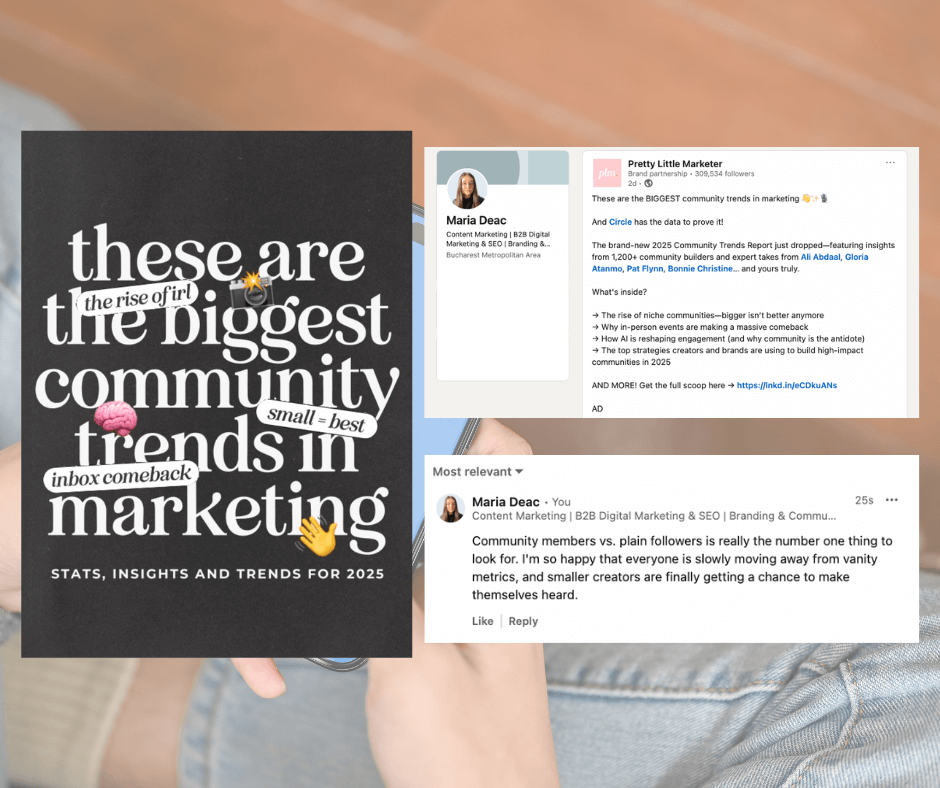Haven’t you heard the latest rumor yet? Nearly all social media marketers chatter these days that commenting will outshine posting as a growth strategy. But actually, this is not someone’s fantasy or baseless gossip spread across the digital space. As we approach a...
Social media community management: the definitive guide for 2026

Social media community management refers to the ongoing process of building genuine relationships with your audience. Community managers don’t necessarily post content, but rather, they are responsible for creating a space where brands and audiences exchange real engagement.
Duolingo, Beis, Ryanair, The Ordinary, RedBull, these are household names in the online community, and it’s no coincidence. They’ve built strong, active communities where followers are welcome to engage and become part of the brand. But this isn’t just a B2C thing. Even larger B2Bs, like HubSpot, have succeeded by fostering communities that drive interaction and growth.
So, in this guide, we’ll explore what makes community management work and how social media community management tools can help you build and scale your own.
What is the primary goal of community management on social media?
Social media community management involves building, growing, and nurturing a brand’s online community across social platforms. It includes engaging with followers, responding to comments, fostering discussions, and maintaining brand presence. The goal is to create an active, loyal audience that feels connected to the brand and its values.
What is a social media community manager responsible for?
A social media community manager is one who turns followers into loyal advocates. They’re responsible for audience engagement, responding to comments, sparking conversations with potential customers, and creating a space where people feel heard and valued. They monitor interactions, handle customer concerns, and keep the company’s voice active. They’re also the ones who run engagement campaigns and identify potential brand advocates to boost social media efforts.
Unlike a social media manager, who focuses on content creation, scheduling, and strategy, a community manager’s role is to build real relationships.
Why social media community management is important?
Social media community management is what holds your brand’s relationship with its audience together. Here’s why:
It boosts brand visibility
Community management drives social media engagement, which in turn, increases your social media presence. When community managers actively interact with community members, content is shared and social mentions rise, which pushes your brand in front of more people.
Brands like Beis excel at creating ongoing conversations that encourage social media discussions and spark real-time dialogue across different platforms.
And this goes for all social media platforms. For instance, TikTok just released information about their algorithm, which reveals that they’re using a points system to push out videos. Guess what counts? Likes, comments, reposts, rewatch times, and more – they all play a huge role in how well your content performs. In other words, if your social media community management strategy performs well, your content has a better chance of reaching your audience.
It helps you gain target audience insights
Community management is how you tap into your audience’s pulse. It’s not passive, as it sparks ongoing conversations that provide the insights you need to shape your brand. People love it when you engage with them on social media. As a result, many engage back, which only creates more engagement in the end due to the “herd effect” and enough social proof to get people to comment.
These conversations reveal what they care about, love, hate, and feel is missing. The key is tracking these discussions to uncover:
- What do they talk about when you’re not there?
- What are they feeling when your content lands in their feed?
Do so by tracking metrics like:
- Engagement rates: show how invested your community is
- Sentiment analysis: tells you their perception
- Social mentions: give you a sense of the conversation happening around your brand
- Common topics: give you insights into the brand narrative
Once you’ve got these metrics in your hands, you can tweak your content marketing strategy based on what your community wants more of, and just as importantly, what they want less of.
It improves brand reputation
Engaging with community members helps you build trust, and when done right, it transforms negative comments or feedback into opportunities for growth. One great example of this is Ryanair, a master of taking negative comments about their low-cost fares and turning them into fun, natural ongoing conversations.
However, sometimes, more serious concerns may be at stake. When community managers step in and address concerns promptly, it shows that your brand values its audience and is committed to delivering on promises.
My tip is to keep a pulse on brand sentiment using integrated social media analytics. Developing a structured social media listening strategy helps you systematically track these sentiment changes and respond proactively to community concerns.
Monitor customer reactions to your posts, campaigns, and overall brand message. When you actively engage with community members, you turn passive followers into active participants.
It builds customer relationships
When you actively engage with community members, you turn passive followers into active participants. This builds a sense of belonging, which is powerful. Some community management techniques to foster this brand sentiment include encouraging conversations, sharing user-generated content, and celebrating milestones with your brand’s audience.
For companies, the benefits are clear: brand loyalty increases, community feedback becomes more actionable, and your audience becomes an essential part of your brand’s growth.
How to build a successful social media community management strategy
Effective community management needs a clear plan focused on engagement, authenticity, and growth. In this section, I’ll break down the steps you need to build one.
1. Identify your target audience
The first and most important step in community management is understanding who your audience is and where they spend their time online. You need to know where they engage, what they care about, and what drives their behavior.
Knowing your target audience and their habits allows you to choose the right platform for community building. One great tool I use to find this information is SparkToro.
For example, if you’re targeting young professionals, LinkedIn might be the best channel for in-depth conversations and content sharing. Once you’ve pinpointed the right platform, you can tailor your content and social media management approach to suit the specific needs and interests of your community.
2. Establish the goals you want to achieve
Without clear goals, your community engagement efforts will lack direction. Are you aiming to increase brand awareness, foster customer loyalty, or boost conversions? Your goals will shape how you approach community management.
For example:
- If your goal is brand awareness, you might prioritize creating shareable, buzz-worthy content to get people talking about your brand.
- If your goal is conversions, you’ll need a strategy focused on building trust and delivering value through thought leadership content and engaging directly with your community.
Different goals mean different tactics, and being clear on what you want to achieve will help you stay focused.
3. Decide on your approach to moderation
When you create a community, you also create a space where interactions can go off-track. That’s why you need a clear moderation policy and the right moderation tools to enforce it. The internet is wild and unpredictable, which means that sometimes, negative or malicious behavior will crop up.
Community guidelines are in place to maintain a positive environment. But you also need your very own set of community standards and rules. For your brand to thrive regardless of who in your current or future marketing team is managing it, you should outline what’s acceptable behavior, how to handle criticism, and the consequences for violating rules.
Here are a few examples of ground rules that you can include:
- All members must engage respectfully. No hate speech, slurs, or personal attacks are allowed.
- Criticism and negative feedback are welcome as long as they are focused on the product or service, not personal attacks.
- Keep conversations relevant to the community. Off-topic discussions will be removed.
- Avoid self-promotion or spamming unless approved for collaborations that relate to your brand authenticity.
- Always use kindness in your interactions, even when disagreeing.
To make social media moderation easier, Planable offer built-in engagement features that help you keep your community spaces safe and supportive. You can:
- Delete inappropriate or off-topic comments directly from the platform.
- Group comments by sentiment, so you can quickly prioritize responses. Whether they’re questions, complaints, or positive mentions.
- Use AI-powered reply suggestions for those busy days when creativity is low but your audience still needs your attention.
- Manage LinkedIn personal profile comments for posts you’ve created through Planable, extending your moderation capabilities beyond just company pages.
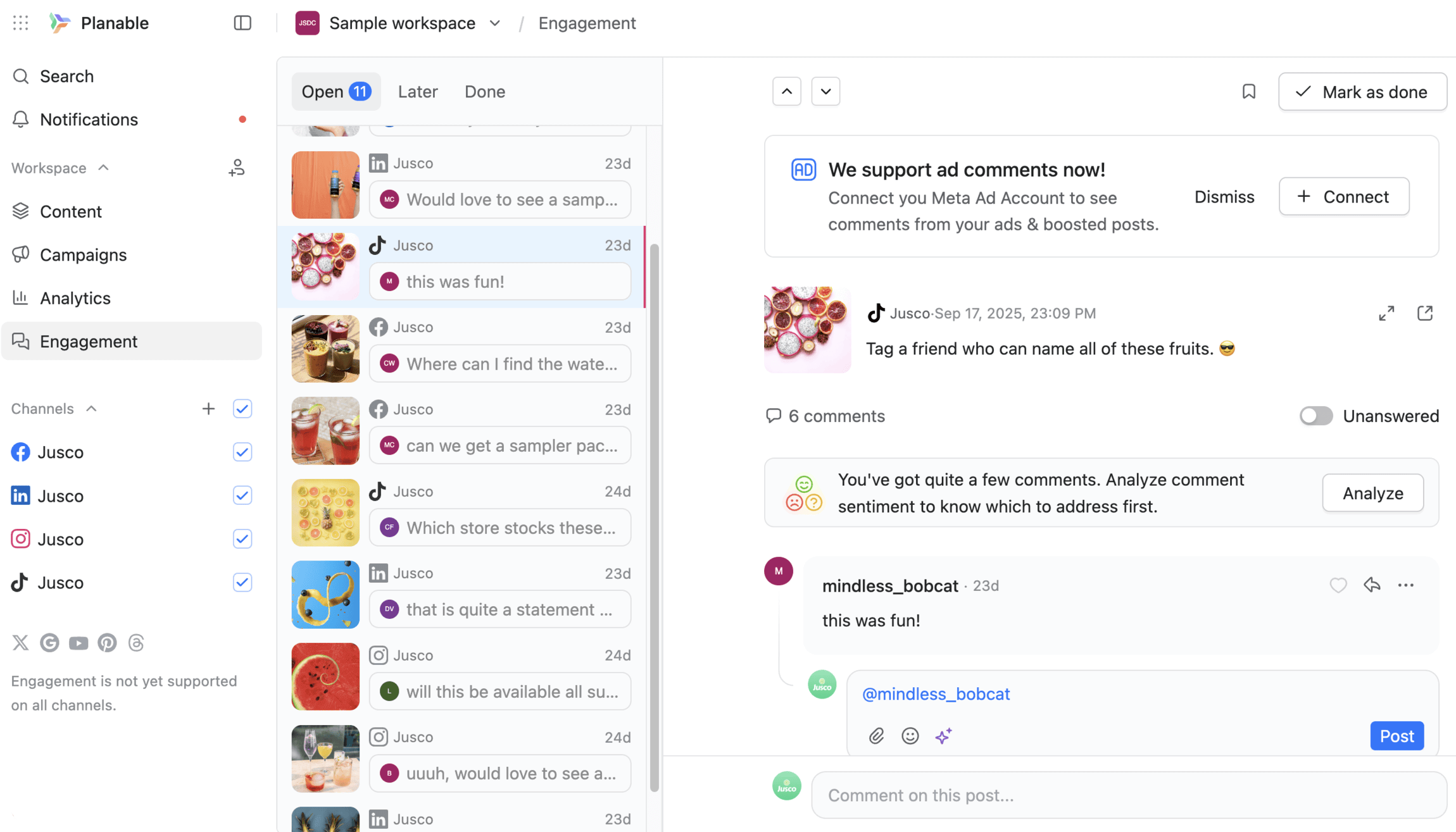
Analyze comment sentiment in Planable to prioritize which social media replies matter most
These features save time and help ensure that your community moderation stays proactive, consistent, and aligned with your brand voice, no matter the mood of the feed.
4. Engage with your community
Active engagement with your community is the foundation for building real, lasting relationships. Interaction shows that you care about your audience and encourages them to connect with you on a deeper level.
- One effective way to drive engagement is by encouraging user-generated content. Learning how to schedule the first comment also helps spark initial conversations. When brand communities share stories, photos, or experiences, it strengthens your bond while boosting word-of-mouth marketing.
- A key strategy is providing timely responses. Answer questions, acknowledge praise, and address complaints as you receive them to keep yourself top-of-mind.
- Another way to drive engagement is by posting regularly and creating an anticipation sentiment in your audience’s mind. If you’re looking to streamline this process, consider using tools like Planable to schedule social media posts.
To handle this smoothly, tools like Planable allow you to not only schedule social media posts in advance but also collaborate on content, monitor interactions, and respond to comments in real time, all in one place. This keeps your community conversations consistent and timely, even as your team scales.
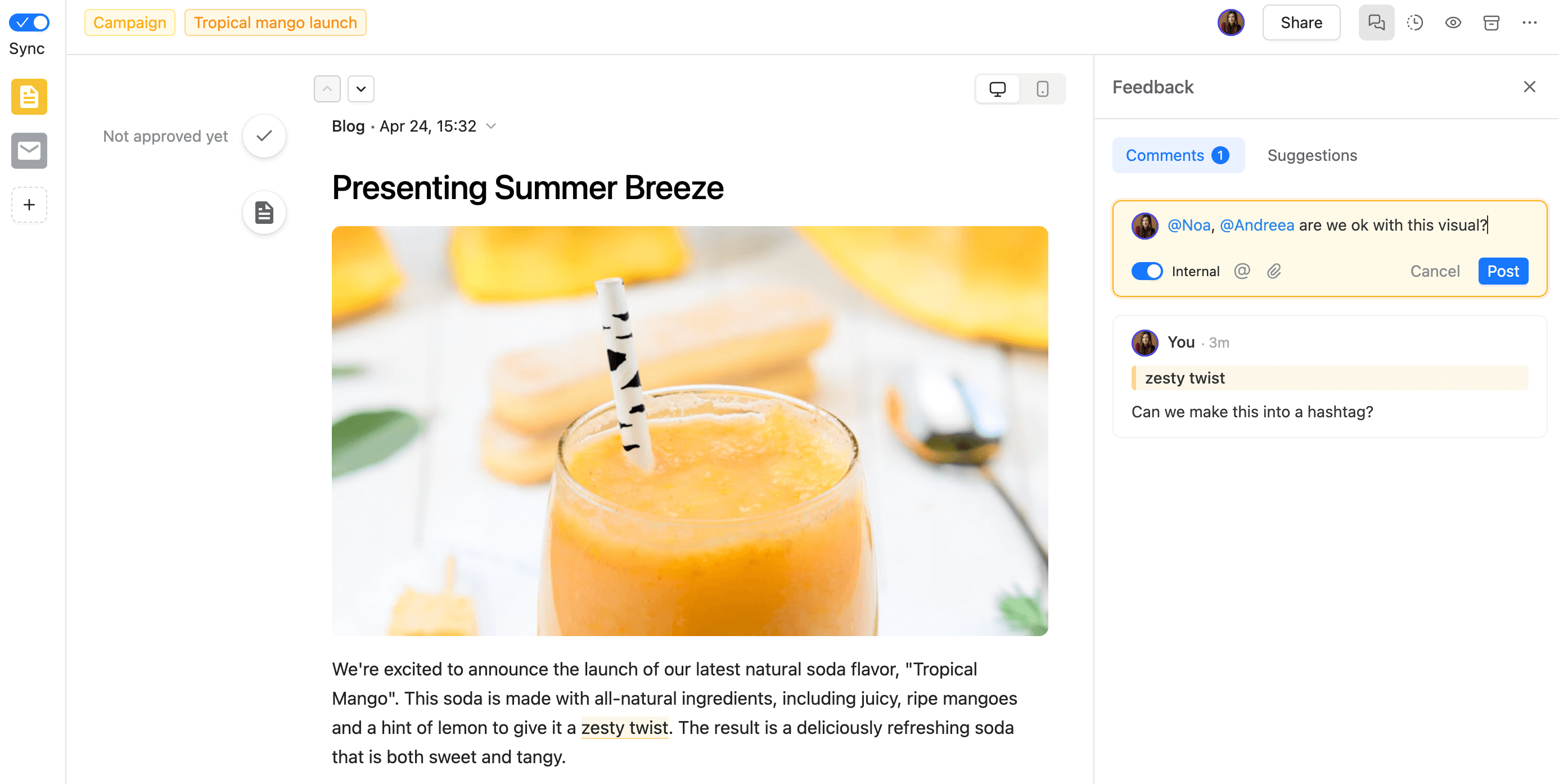
Content collaboration in Planable
5. Track performance and measure results
Tracking performance, although tedious at times, will help you see if you’re headed in the right direction. For better content development, and to to keep improving your content, create custom reports either manually by analyzing your desired metric or by exporting native app reports.
With Planable’s analytics, you get a complete, centralized view of your social media performance. Track account statistics over any custom time range, uncover what content is resonating most with your audience by identifying top-performing posts, and dive deep into performance insights for each piece of content, including your boosted posts and ads on Instagram and Facebook.
You’ll also gain valuable audience insights, such as location, demographics, or professional background, helping you better tailor your messaging. And when it’s time to report, you can quickly generate professional reports as downloadable files or shareable links, making collaboration with clients or teams effortless.
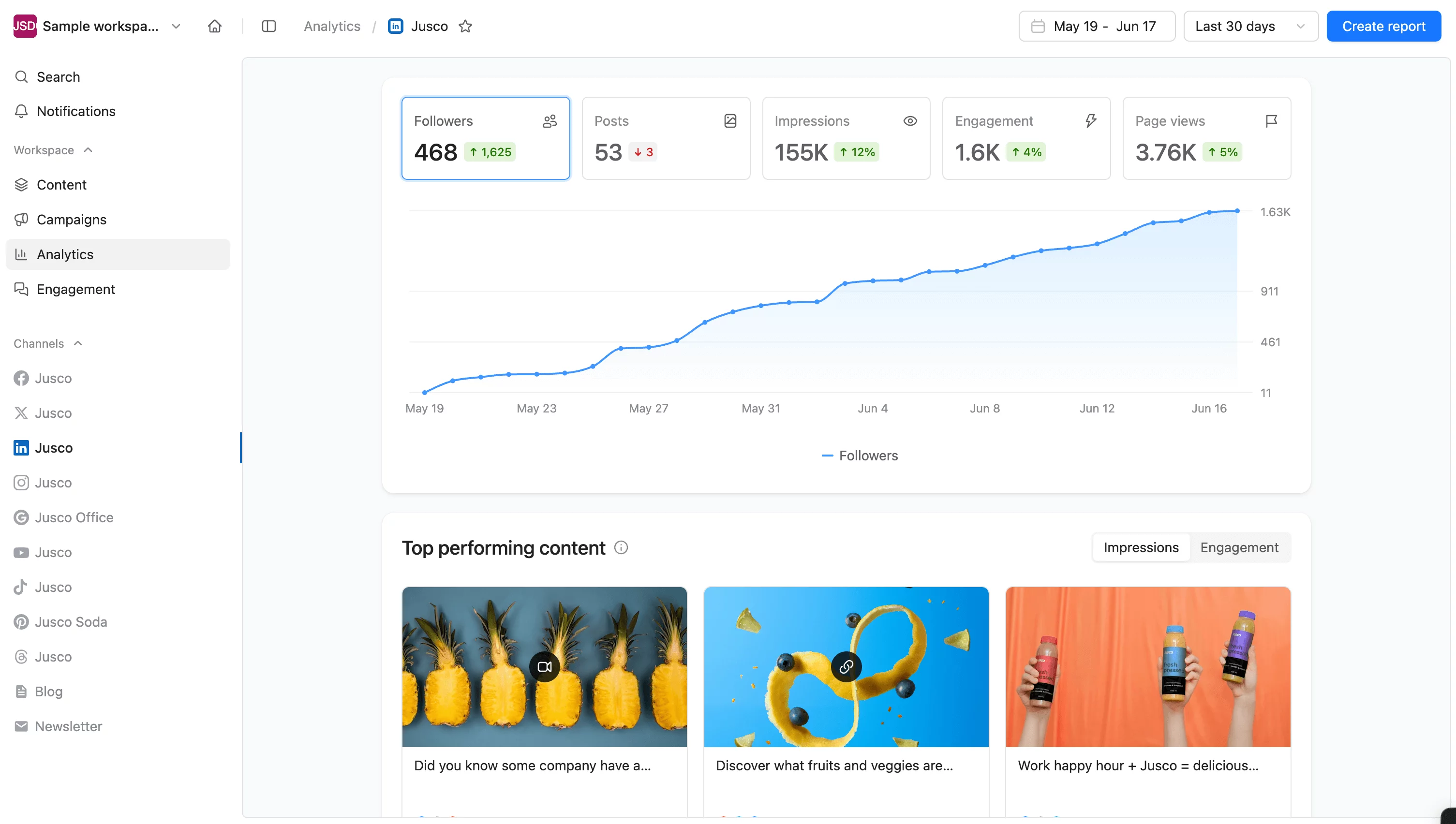
Easy-to-read post analytics in Planable
Once you collect your reports, here’s how to measure, interpret, and act on the data:
- Engagement rates are your go-to metric for understanding how your audience is interacting with your content. Look at the number of likes, shares, comments, and interactions. If engagement is low, it means your content isn’t resonating, and you need to pivot or A/B test.
- Sentiment analysis tracks how people feel about your brand. Are comments positive, neutral, or negative? Use social listening tools to analyze your brand’s personality across socials and find ways to shift your social strategy if need be.
- Brand mentions show how often your brand is being talked about and in what context. If your community is talking positively about you, you can use that in future campaigns. If mentions are negative, check out the conversations to understand the root cause and address it directly.
- Retention rates show you who’s sticking around. If your community engagement spikes but retention drops, you might be gaining attention without creating lasting connections. High retention rates mean you’re also successfully building relationships. Low retention means it may be time to rethink your community engagement or content strategy.
Try to benchmark your performance against industry standards. For example, if your engagement rate is 2% but the average for your industry is 5%, set a goal to increase by 1-2% over the next quarter. Use a social media report to track this data across platforms so you can spot trends and make adjustments.
4 social media community management best practices
Building a strong community is a deliberate, ongoing process that blends strategy, consistency, and active engagement. So, let’s get into my top four community management best practices that will help you grow those thriving, loyal communities and boost brand advocacy.
1. Give people a reason to engage regularly
The first step in community management is engagement. Without it, a community is just a list of new team members. You need to give them a reason to interact with your brand regularly. Consistency is key here. You need to plan content ahead of time so your community knows when to expect new interactions.
By sticking to a schedule, you show your community that you’re committed to providing them with value and creating a space for ongoing conversations. Brands like Beis do this exceptionally well, running campaigns that get their followers involved, like their regular travel updates, which encourage followers to share their own tips and experiences.
One of the best ways to do this is by creating a social media calendar that provides consistent and valuable content for your community. Plan your content in advance, including regular features like Q&As, polls, or interactive challenges.
With Planable, managing this process becomes effortless. You can view and organize your content in four different ways (feed, grid, calendar, or list), giving you a flexible, bird’s-eye view of your publishing strategy.

Social media calendar in Planable
The list view makes it easy to approve, schedule, or edit posts in bulk, saving time and boosting efficiency. Even better, you can create posts in pixel-perfect previews for each social platform, ensuring your content looks exactly the way it should before it goes live.
2. Become an active member of other communities
It’s not enough to just engage with your own followers, and that’s especially true on LinkedIn and Instagram. When building communities, you need to go where your target audience already is. Active participation in other communities related to your niche helps you build credibility and increases brand visibility.
Look to spark meaningful conversations on Reddit threads, LinkedIn groups, or Facebook groups by positioning yourself as a knowledgeable brand voice.
Look for communities that align with your brand’s values by simply looking up keywords of interest via the social media app or through specialized social research tools.
Once you find them, engage by sharing helpful tips, starting discussions, and making valuable contributions. Try, as much as you can, to avoid just promoting your brand or being spammy.
3. Remove harmful participants
Toxicity can quickly derail a healthy environment, so you need to have clear community guidelines and enforce them consistently. Define what’s acceptable, be it language, tone, or behavior, and make sure that these rules are visible and easily accessible.
If someone is violating these guidelines, take action. Offer a warning first, but if necessary, remove the individual to maintain the integrity of your space.
4. Use the right community management tools
As your community grows, it can quickly become overwhelming. To stay organized and maintain consistent engagement, you need to use social media community management tools that help streamline your efforts.
If you’re serious about your content, sooner rather than later, you’re going to have to schedule social media posts, monitor engagement, track comments, and analyze feedback alongside social mentions professionally.
Additionally, I recommend setting up analytics tools to track engagement rates, sentiment analysis, and social mentions, as they will help you measure how your community feels about your brand.
Create a social media community to boost your brand online
Building a social media community takes consistent effort, genuine engagement, and real-time adaptation. But the payoff is massive: loyal customers, consistent engagement, and more brand advocacy. While it sounds cliche, the key is to really make your community feel heard and valued.
One way to do so is to go beyond broadcasting content and create genuine connections and two-way conversations that give your audience a seat at the table. Do so whenever you get the chance: through your posts, via the copy, in the comments, in your stories, and via other avenues that may spark their interest.
With Planable, you can do all of this seamlessly. From planning and scheduling content to managing engagement and tracking performance. If you’re ready to build a thriving social media community, start with the platform built for collaboration, clarity, and consistency. Start free with Planable today!

Maria is a content marketer, SEO copywriter, and social media specialist with experience working for a wide range of B2B businesses. She loves to keep up with the evolution of digital marketing, particularly in areas such as social media management, content, SEO, and PR. She is passionate about her work and loves to add a unique spin to any topic.



